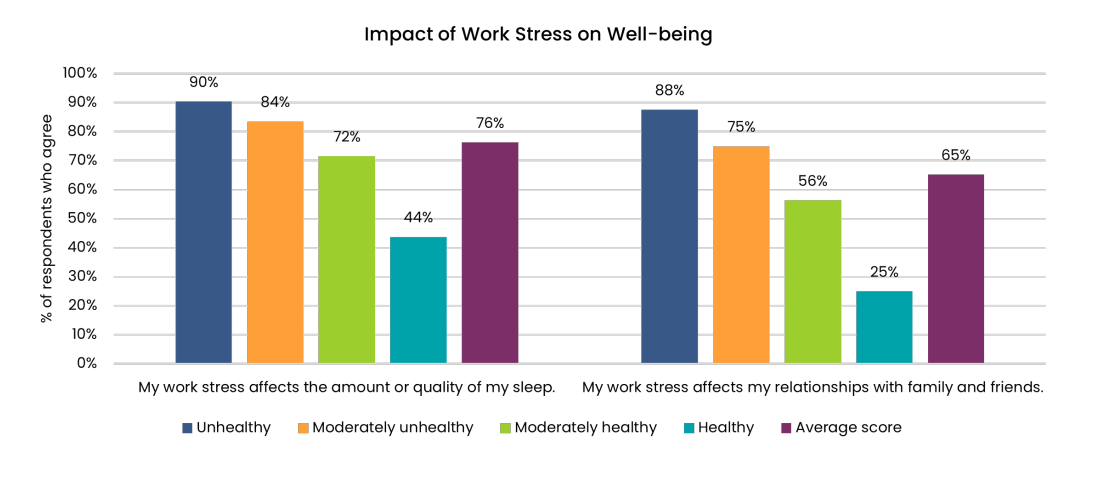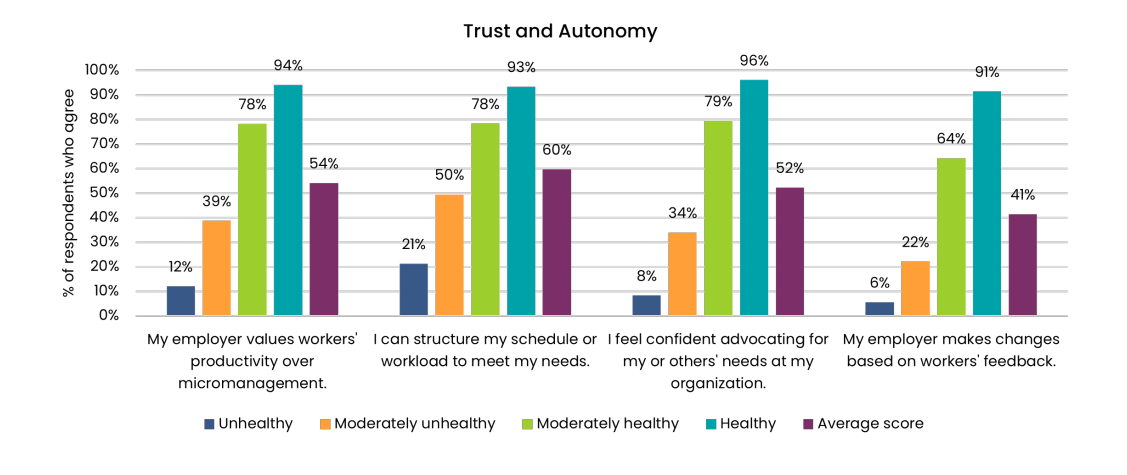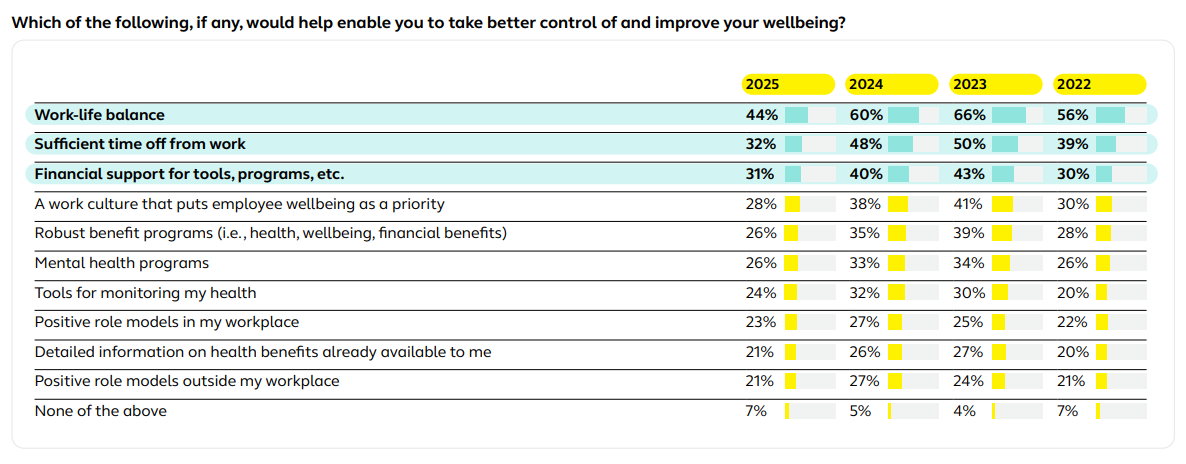Workplace wellness, also known as employee wellness, focuses on supporting employees’ physical, mental, and emotional health. Wellness programs, employee recognition software and employee rewards programs aim to boost job satisfaction, improve work-life balance, and create a positive work environment, often forming a key part of employee benefits packages.
While wellness itself isn't new, strategies for promoting employee well-being are rapidly evolving. This article highlights the latest employee wellness statistics to help business leaders and employees stay informed about current trends and adapt effectively.
Looking for Corporate Wellness Programs and Companies? Check Out These Platforms Our Experts Recommend

Key Corporate Wellness Trends
- The global workplace wellness market was valued at $57.9 billion in 2023 and is projected to grow at a 7.2% annual rate between 2024 and 2034, reaching $124.3 billion by the end of 2034.
- Most workers (85%) report having access to at least one employee wellness program, such as mental health apps, nutrition coaching, or stress-management workshops.
- Although benefits are widely available, the average usage rate remains around 30 - 35% per program. 60% of employees understand their benefit options and feel confident in their choices. These informed workers tend to have 25% higher loyalty scores and are 40% more likely to see their benefits as an investment in their future.

Stats on How Much Corporate Wellness Programs Cost
- Employers can see workplace wellness programs as a way to mitigate rising employee healthcare costs. Total employee healthcare costs are expected to go up 7% for current health plans.
- Wellness plans that prioritize prevention and early action can potentially save employers money in the long and short term. For those worried about profitability, industry reports show a $1.47 return on investment for every dollar spent on corporate wellness initiatives.
Wellness programs can come in all shapes and sizes, but a few common denominators exist amongst companies’ offerings.
Studies from both Alight and the International Foundation of Employee Benefits found that employee assistance programs (EAPs) are increasingly offered by mployers. As of 2025, 85% of workers have access to at least one wellness program, up from 78% just three years prior, according to Alight. Despite the growing number of these programs, their actual usage remains relatively low. While most workers recognize the potential benefits of these programs, only about a third of them actually use them when available.
However, among those who do use these benefits, 85% find them valuable. Healthcare navigation support is becoming a crucial employee benefit, with around one-quarter of workers now having access to personalized assistance. These services go beyond just providing basic information, offering comprehensive support like provider recommendations, cost estimates, prescription reviews, billing advocacy, program referrals, and appointment scheduling assistance.
This support is available through various channels, with 23% of workers having electronic access and 28% having face-to-face options via phone or virtual meetings. Although the availability of these services hasn’t increased, their usage has skyrocketed. Nearly two-thirds (64%) of workers with electronic navigation assistance reported using it in 2025, a 12-percentage-point increase from 2024. Similarly, 59% of workers with face-to-face services used them, a five-percentage-point increase. This growing adoption suggests that workers are increasingly valuing the support and guidance provided by personalized navigation services.
Other support resources that were popular amongst employers included:
- Mental health services, provided by 86% of employers
- Substance abuse disorder benefits, offered by 67% of employers
- Mental health mobile apps, to which 41% of employers have access, and
- Educational sessions were held at the workplace in the case of 40% of surveyed employers.
Employers also use incentives to encourage participation. Over 40% of organizations surveyed use gift cards and/or other employee benefits insurance perks like reduced premiums.
Benefits of Corporate Wellness Programs: Key Statistics
Workers are interested in improving their financial, physical, and emotional well-being.
- The vast majority of employees care about wellness. In a study from Deloitte, 91% of respondents shared that they have goals for their wellbeing.
- Moreover, 75% of employees and 89% of C-suite executives surveyed reported that improving their well-being is a top priority for them.
- That same report found that 68% of employees and 81% of C-suite executives say that working on their well-being is more important than advancing their careers.
Employees are concerned about wellness in every sense of the word. When asked about top priorities, over 75% of respondents cited the following concerns: “not living above my means or staying within my means,” “eating healthy,” “Effectively managing or balancing my work and personal commitments,” and “getting enough exercise.”
With employees deeply invested in their well-being, organizations that support wellness efforts can see measurable returns.
- Improved productivity: According to a study from the University of Johannesburg, “employees that are happy and healthy can be higher in productivity, engage better, avoid leaving work hence have lower turnover, and create better organization culture”. Similarly, another study notes that employee wellness programs are “effective to improve both productivity and health of workers.”
- Healthier work culture: The University of Johannesburg also emphasizes that improved employee well-being contributes to stronger engagement and a more positive organizational culture.
- When employees thrive, businesses do too. According to research by Alight, there's a notable difference between employees with high and low wellbeing. Those with high wellbeing are more committed to their organization’s mission (81% vs. 44%) and are twice as likely (81% vs. 40%) to say their workplace has a positive atmosphere. They’re also more likely to stay with their current employer (64% vs. 49%) and share positive stories about their workplace (80% vs. 43%). Additionally, they’re nearly 2.5 times more likely to recommend their employer to others (84% vs. 34%).
Corporate Wellness Statistics in the US and Global
People leaders and benefits managers face a no easy task in improving the well-being of their workforces.
- A 2022 global report from Gallup shows that only 33% of employees are “thriving” in their wellbeing.
- 44% of employees reported experiencing “a lot” of stress the previous day, while 40% reported worrying.
At a global level, employee engagement and well-being are also quite low.
- Only 21% of international employees state that they are engaged at work, and roughly a third of employees report that they are thriving in their overall well-being.
- Employees from Australia and New Zealand (63%) and the United States and Canada (60%) have the highest shares of thriving employees, while Sub-Saharan Africa (21%) and South Asia (11%) have the lowest.
Gallup’s study found similar results in terms of financial wellness.
- 55% of workers from Australia and New Zealand and 51% from the United States and Canada expressed that they are living comfortably on their current income.
- In comparison, under 28% of employees from all regions outside of Western Europe responded positively. It’s clear from these workplace wellness statistics that employees are under economic pressure.
Statistics on Mental Health Benefits: A Priority for Employee Wellness Solutions
According to the same Gallup study, the majority of employees recognize the importance of mental health coverage, with 4 out of 5 agreeing that it is as important as, if not more important than, physical health coverage.
- Despite this, only 61% of employees have access to mental health care as part of their benefits package.
- The numbers are even lower for small-business employees, with only 54% reporting access to mental health coverage.
- These concerning statistics are further supported by the fact that over one-third of employees (37%) have delayed seeking treatment for a mental health issue because they are unsure if their health insurance plan covers it.
- In 2023, only 56% of employees feel in control of their well-being.
- The percentage of employees who feel their employer cares about their well-being has decreased from 47% in 2022 to 41% in 2023.
- Only 43% of employees feel supported by their employers in managing and improving their wellbeing, a 10% decrease from 2022.
- Nearly 4 in 10 employees (38%) report that their employers have discontinued various well-being programs, including stress management, nutrition, parental and caregiver support, and mortgage assistance, in the past year.
With mental health concerns on the rise, it is imperative that companies prioritize mental health care for their employees and ensure that it is included in their benefits packages to support their overall well-being.
Employee Wellness Statistics Reveal Issues with Workload, Burnout, and Toxic Environments
Though wellness is a priority for many employees, it remains elusive, often due to work itself.
- 30% of U.S. workers report that their job adversely affects their mental health.
- Most employees (76%) believe work stress impacts their sleep. But in unhealthy workplaces, that number jumps to 90%, compared to 44% in healthy ones.
- Regardless of age, employees report high levels of work stress that impact their personal relationships, with nearly two-thirds saying it has an effect.
- Most employees (83%) and executives (74%) encounter challenges in achieving their well-being goals, which are primarily linked to their work.
- Specifically, the top two hurdles reported were a demanding workload or a stressful job (30%) and inadequate time due to long work hours (27%).
- For a whopping 80% of employees surveyed by Mental Health America, stress affects their relationships with family, friends, and coworkers.

High-stress levels can come from many sources, including work, but are typically due to many factors compounding with little or no recovery time. Find more statistics on workplace stress here.
- Burnout is a significant issue. Nearly half of workers worldwide (46%) report suffering symptoms of burnout. This affects women at a higher rate than men: 42% of female vs. 30% of male employees experience at least moderate levels of burnout.
- Most of those reporting high levels of burnout have also experienced other mental health challenges, such as anxiety, depression, and trouble sleeping, within the past year.
- Moreover, stress, burnout, and other emotional challenges can result in unproductive presenteeism or increased absenteeism.
- Gen Z employees and Millennials have lower overall work health scores than other generations. In fact, 71% of Gen Z employees and 59% of Millennials had unhealthy work health scores, compared to 52% of Gen X employees and 42% of Baby Boomers.
- Employees who work part-time or mostly on their feet in a fixed location tend to have lower overall work health scores. Specifically, 69% of employees who work on their feet at a single location have unhealthy work health scores, compared to 47% of those who work remotely at a desk.
A toxic work environment is a harmful, stressful, or unpleasant workplace for employees due to various negative factors. These indicators range from bad communication practices and poor management styles (particularly micromanagement) to overt discrimination and bullying.
Toxic work environments are critical indicators of employee burnout and other well-being issues.
- Unfortunately, these types of workplaces are not uncommon. Roughly one in five employees (18%) describe their workplace as toxic.
- Employees in manual labor and customer service roles reported higher rates of toxicity (22%).
- Harassment, verbal abuse, and physical violence in the workplace are also alarmingly prevalent, with 22% of employees reporting that someone within their organization abused them verbally at work.
- Employees in Gen Z feel less secure at work, both mentally and emotionally, compared to other age groups. A whopping 63% of Gen Z employees said they aren't confident speaking their minds, and 60% feel like they can't be their authentic selves on the job.
Toxic work environments are connected to employee burnout. In a global report from McKinsey on workplace culture, toxic workplace culture was the biggest predictor of burnout symptoms by a large margin.
Statistics on Employee Financial Wellness
Employee financial wellness is a crucial concern for workers.
- Bank of America found that only 44% of employees feel “financially well” a five-year low.
- In a 2021 study from Alight, 81% of employees reported that “not living beyond my means or staying in budget” was of high or moderate priority for them. This issue also ranked in the top five concerns for employees of all age groups, showing that budgeting is really important to workers across generational boundaries.
- Moreover, nearly 60% of employees are concerned about an impending recession.
Unsurprisingly, the ramifications of financial stress spill over into other areas of wellness.
- In a report from PWC, participants shared that, in the past year, financial stress and money worries have had a big impact on their mental health (34%), sleep (33%), and physical health (23%).
- Those with existing financial troubles or responsibilities are even more impacted. Nearly half of the surveyed employees who self-identified as financially stressed stated that money worries “had a severe or major impact on their mental health.”
Employers should keep in mind that financial concerns can be a significant burden that many employees deal with silently.

Employee Wellness and Retention Statistics
Wellness is essential to today’s workforce, and many employees are considering leaving for greener pastures.
- The previously mentioned study from Deloitte reports that 57% of employees and nearly 70% of executives are seriously considering leaving their organizations for a more “supportive” job.
- Unsurprisingly, a toxic work environment is a key predictor of intent to leave. In McKinsey’s report, researchers found that across all 15 countries surveyed, toxic workplace behavior was by and large the most significant indicator of turnover intentions.
- This report further explores the topic of employee adaptability, which is often (incorrectly) linked to the tolerance of toxic behavior. Surveyors found that even though more adaptable employees might be able to tolerate toxic environments temporarily, they are more likely to leave. In fact, employees with high adaptability in toxic environments were 60% more likely to intend to leave than their less adaptable counterparts.
Research by Alight shows that employees with comprehensive workplace benefits tend to be more engaged and loyal to their employer. Specifically, 67% plan to stay with their current employer. Additionally, 76% say they speak highly of their organization when given the chance, 64% report having an exceptional employee experience, and 38% are highly likely to recommend their employer to others.These researchers concluded that “relying on improving employee adaptability without addressing broader workplace factors puts employers at an even higher risk of losing some of its most resilient, adaptable employees.”
Financial wellness also has a dramatic impact on retention.
- Among the 29% of employees actively looking for a new job, 65% share that money is the primary motivator.
- Additionally, financially stressed employees are two times as likely to be on the job hunt.
For more information on retention, check out this article with relevant employee retention statistics.
Data-Driven Approaches to Employee Wellness: Key Statistics and Solutions
Supporting employees’ mental health can take a variety of forms, and corporate wellness software can help you manage your offerings.
When in doubt, ask your employees what support they want. Researchers from the American Psychological Association (APA) found that, out of a list of 12 potential supports, the most popular supports were:
- Flexible work hours: 41%
- A workplace environment that “respects time off”: 34%
- Remote work options: 33%, and
- A four-day work week: 31%
According to Mental Health America, trust and autonomy, value and appreciation, psychological safety and belonging, as well as equity and support, are essential for enhancing employee well-being. As noted in its latest report:
- Employers who prioritize productivity over micromanaging recognize the value of open communication. Among employees who felt their employer prioritizes productivity over micromanaging, 94% strongly agreed that their employer encourages transparent communication throughout the organization.
- Training for people managers and flexible work options help promote autonomy and support employees’ work-life balance. In workplaces that offer this training and flexible work arrangements, 74% of employees can tailor their schedules or workload to meet their needs.
- Less than half of employees felt their employer made changes based on their input. However, among those who did, 91% strongly agreed their employer invested in developing fair and supportive managers, and 85% strongly agreed their employer promoted transparent communication at all levels.
- Employees who are passionate about their work tend to feel a stronger sense of belonging in the workplace. Among employees who found their work energizing and fulfilling, 90% strongly agreed that they felt a sense of belonging at work.
- Most employees know they're valuable at work, but often don't get recognized for their efforts. A whopping 78% of employees say they understand how their work helps their organization succeed, yet only 59% feel truly appreciated by their employer.
- When employees feel more psychologically safe, they're more confident in speaking up for themselves and others at work. In fact, 87% of employees who felt confident sharing their opinions with their team also strongly agreed that they felt confident speaking up for themselves and others.
- Open communication and supportive management are closely tied to trust, appreciation, and a sense of safety. Still, fewer than half of employees felt that their employer promotes clear and transparent communication (47%) and invests in training fair and supportive managers (45%).
- Employers who grasp their employees' needs can offer the most suitable and effective benefits. Among employees who felt their employer tailored benefits to their needs, 81% strongly agreed that their employer made changes based on employee feedback.

Meanwhile, in its 2023 Global Mindset Report, Elight pointed out the top five benefits employees rated as priorities for their well-being: work-life balance (66%), sufficient time off work (50%), healthy work culture (41%), more wellbeing resources (39%), and more mental health programs (34%).
An empirical study of Japanese workers found that, among other factors, "ability to work at one's own pace" has a negative relationship to stress levels. Data from Alight’s Employee Mindset Study backs this up: Remote workers (86%) are the most satisfied with their work setup. On the other hand, onsite employees are less likely to feel connected to their company's mission or motivated to do their best work. If their employer implemented a mandatory return-to-office policy, 33% of remote workers would consider leaving. Think about how your company culture supports flexible work arrangements.
A straightforward solution is to build and encourage a company culture of taking breaks.
Taking big and small breaks throughout a workday can significantly reduce employee stress, result in fewer sick days, and delay or prevent the onset of burnout. Deloitte found that only around half of employees use all of their paid time off, get sufficient sleep, take microbreaks during the day, and spend enough time with their families and friends.

Over the past four years, workers have consistently told Alight that work-life balance, enough time off, and financial support would help them take charge of and improve their well-being. Additionally, about one-quarter of respondents said things like work culture, health tracking tools, and detailed benefits information are also helpful for improving their well-being.

Employers, therefore, should take a look at their benefits offerings to ensure that there is enough vacation time. Consider a wellness challenge that rewards employees for taking consistent breaks or performing other healthy behaviors. Additionally, senior leaders should model healthy behaviors like taking time away from work, taking breaks for physical activity, and leading full, sustainable lives outside of work.
How managers approach and encourage employee wellness also has a major impact on the bottom line of employee wellbeing.
- Mental Health America found a positive relationship between investment in developing supportive managers and overall healthier workplace scores.
- Unfortunately, only 40% of surveyed employees reported that their company does so, and only 59% of employees felt that their manager cares about their personal wellbeing.
- For workers with mental health benefits included in their health insurance package, 93% feel that this is an effective support.
Managerial support has a strong connection to employee empowerment and mental health outcomes. Given these numbers, it’s important to evaluate your manager training programs and ensure that proper attention is devoted to teaching people leaders to actively support their direct reports’ wellbeing.
When evaluating your wellness strategies, take a look at your health insurance offerings, as well as economic support. Starting a financial wellbeing program can be a massive help for employees.
Employees who work at organizations with such programs report a greater feeling of control over their finances and future than those at workplaces without (56% vs. 42%, respectively).
Financial wellbeing programs can take many shapes. The study from Alight mentioned earlier found that the top programs by employee usage (if available) are:
- Remote work reimbursement: 89%
- More frequent payments: 84%
- PTO exchange: 81%
- Access to low-interest short-term loans: 80%
- One-on-one financial support: 79%, and
- Mortgage assistance programs: 79%
Financial wellness platforms for employees can help employees take matters into their own hands.
Corporate Wellness Statistics: Summing Up
Corporate wellness programs are a crucial component of an organization’s benefits offerings. By investing in your employees’ emotional, mental, and financial well-being, you can create and sustain a workforce that is engaged, motivated, and, most importantly, healthy.
Healthy employees will champion your company’s mission and make a positive impact on company culture. Be sure to review your current wellness strategy and consider asking your employees for suggestions on how to make it more robust, accessible, and supportive.
References
- “2025 Employee Mindset Study.” Alight, Alight Solutions, 2025
- “2022 PWC Employee Financial Wellness Survey.” PwC, PwC,
- “2022 Workplace Benefits Report.” Bank of America, Feb. 2022,.
- Adams, T., Craig, S. & Fritze, D. (August 2024). Mind the Workplace 2024 Report: Healthy Workplaces Lead with Trust and Support. Mental Health America, Alexandria, VA
- "Self-assessed Level of Burnout Currently Experienced among Employees in The United States as of September 2022." Statista, Statista Inc., 11 Jan 2023,
- “APA’s 2022 Work and Well-Being Survey Results.” American Psychological Association, American Psychological Association,
- Brassey, Jacqueline, et al. “Addressing Employee Burnout: Are You Solving the Right Problem?” Edited by Allan Gold and Elizabeth Newman, McKinsey & Company, McKinsey Health Institute, 27 May 2022
- Faber, Terry. “Corporate Wellness Services in the US.” IBISWorld, 2022
- Hatfield, Steve, et al. “The C-Suite's Role in Well-Being.” Deloitte Insights, Deloitte, 22 June 2022
- State of Workplace Burnout 2024 Report, Infinite Potential
- Jobvite. "Main Factors and Benefits Job Seekers Consider When Accepting a Job in The United States from 2021 to 2022." Statista, Statista Inc., 11 May 2022
- Kaiser Family Foundation. "Share of Firms Offering Health Benefits in The United States in 2022, by Firm Size." Statista, Statista Inc., 27 Oct 2022
- Mercer. "Annual Percentage Change in Total Health Benefit Cost per Employee before and after Plan Changes in The U.S. from 2011 to 2023." Statista, Statista Inc., 8 Dec 2022
- Al Soqair, N., & Al Gharib, F. (2023). Toxic Workplace Environment and Employee Engagement. Journal of Service Science and Management, 16, 661-669. https://doi.org/10.4236/jssm.2023.166035
- Shiga, Kiko et al. “Association of work environment with stress and depression among Japanese workers.” Work (Reading, Mass.) vol. 72,4 (2022): 1321-1335. doi:10.3233/WOR-210356
- “State of Remote Work 2022” Owl Labs
- “State of the Global Workplace: 2022 Report.” Gallup.com, Gallup, 20 Feb. 2023
- Workplace Benefits Trends: Employee Well-Being and Mental Health 2022-2023. Aflac
- “Workplace Wellness and Financial Education Programs: 2022 Survey Results” Workplace Wellness Trends, International Foundation of Employee Benefit Plans



























